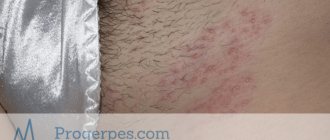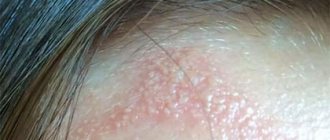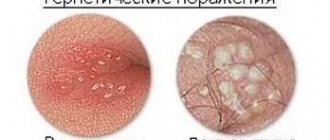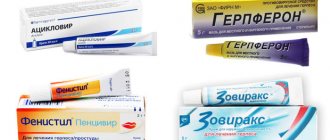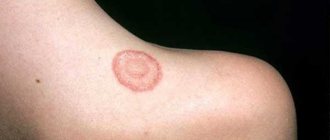Genital herpes is a common infectious pathology that most often occurs in people 20-35 years old. Officially, the disease is called HSV type 2, but since it is more often transmitted through intimate relationships, it is called genital.
The virus affects the mucous membranes and skin of the perineum, including the thighs and buttocks. Herpes on the labia requires treatment. Otherwise, complications may arise, and for expectant mothers, the pathology is fraught with negative consequences for the newborn baby.
What is genital herpes?
Genital herpes (GG) is part of a large group of diseases of various etiopathogenesis, the causative agents of which are sexually transmitted - STDs. HH disease is caused by herpes simplex virus type 2 (HSV-II), less commonly, herpes simplex virus type 1 (HSV-I). The disease is characterized by vesicular rashes on the skin and mucous membranes in the genital area, lower back, thighs and buttocks. Possible asymptomatic and atypical course of the disease, as well as systemic organ damage.
HSV-II and HSV-I are herpes simplex. They are called simple because of their characteristic feature - a vesicular rash on the mucous membranes and skin. This symptom has long been considered the only manifestation of herpes, and the disease was recognized as common and harmless. Clinical observations in recent years have largely changed the attitude of doctors towards this disease.
Genital herpes is a widespread infection. In the statistics of confirmed STDs, the diagnosis of HSV-II occupies a leading position, second only to trichomoniasis. The genital form of herpes is also caused by HSV-I. The results of 20% of tests carried out using polymerase chain reaction (PCR) confirm the participation of HSV-I in the formation of rashes of the anogenital zone. The influence of HSV-I on the formation of genital pathogenesis has been steadily growing in recent years.
The prevalence of the disease caused by herpes simplex viruses is due to the following factors:
- The persistence of opinions about the safety of herpes simplex among ordinary people;
- A long latent stage of the disease in the nodes (ganglia) of the nerve trunks - a person is infected, but does not suspect it;
- Almost lifelong carriage - it is impossible to remove herpes from the body with vaccines, serums or chemicals;
- The possibility of infection through contact and household contact - unfortunately, this factor significantly reduces the age of the first encounter with herpes in children.
In the Russian Federation, since 1993, herpes has been included in the list of diseases subject to mandatory medical statistics. Since the beginning of regular observations, a steady increase in the number of cases of herpes has been recorded. To date, the clinical form of genital herpes is diagnosed in approximately 80 cases per 100 thousand population. This figure corresponds to global statistics on the detection of sexually transmitted herpes. With the help of statistical observations, some epidemic patterns of HH have been established.
The number of cases of genital herpes correlates with:
- The socio-economic status of the sick - the maximum number of cases of illness is recorded in marginal circles, the minimum - in a group with a high social status;
- Gender (men are more resistant to HH infection). The increased sensitivity of women to genital forms of herpes is probably due to the extensive mucous membranes of the external genitalia, and not to a special structure of the immune system;
- Age (there is a sharp increase in cases of HH infection, coinciding with the age of sexual activity). Detectability reaches a maximum by 30-40 years, then there is a gradual decrease in the number of diseases to a minimum by 60-70 years (exceptions not related to human sexual activity are possible).
HSV and another representative of herpes, cytomegalovirus (both STDs), are significant factors in the etiopathogenesis of gynecological inflammatory diseases of the cervix and appendages. The involvement of HSV and cytomegalovirus in the development of radiculitis and inflammation of the meninges has been proven.
The connection between these diseases and the herpes virus was established only after widespread introduction into diagnostics:
- The PCR method used to detect the virus and its fragments in body tissues;
- enzyme immunoassay diagnostic method ELISA or ELISA for typing the antigenic structure of viruses using monoclonal antibodies;
- The emergence of commercial kits for the determination of Ag-HSV-II (antigens to HSV-II) and AT-HSV-II (antibody titers to HSV-II).
The sensitivity and specificity of these methods reaches 95-100%. The time to receive results is from one to two days. Despite the convenience of laboratory methods, their high sensitivity and specificity, they do not always provide adequate results suitable for making a final diagnosis.
Modern laboratory and immunological methods have limitations due to:
- Cross-reactions in the differentiation of specific antibodies HSV-I and HSV-II;
- Low availability of equipment and shortage of specialists proficient in PCR and ELISA techniques in small clinics;
- Expensiveness of high-quality commercial diagnostic kits.
Meanwhile, the absolute value of the PCR and ELISA method is shown for neonatal herpes HSV-II or HSV-I, when specific antibodies are represented by almost homogeneous IgM and IgG, and the patterns of serological reactions fit into standard immune response algorithms.
The value of laboratory methods increases with studies conducted over time at intervals of five to seven days. Some characteristics of the body should be taken into account, for example, the timing of menstrual cycles in women, the medication background of previous treatment and concomitant diseases.
The opinion about the absolute and comprehensive value of laboratory test results in making a diagnosis is a common myth. The diagnosis is made not by a laboratory assistant, but by a doctor based on the symptoms of the disease, patterns and epidemiology of pathogenesis, identified after a complex of physical, instrumental and laboratory tests.
Non-sterile immunity is formed against HSV. Immunoconversion of the body develops within 14-28 days during the latent and clinical course of the infection.
The body's immune response to the primary penetration of the genital herpes virus includes three main components of protective reactions:
- Primary contact of antigens (AG)-HSV-II with cells of the immune system is accompanied by activation of phagocytosis and stimulation of interferon production against the background of the body’s natural resistance;
- The activation of the cellular component of immunity is accompanied by an increase in the level of T-killer and T-helper cells. Increasing the level of B lymphocytes activates the complement system;
- Turning on the complement system activates the production of specific antibodies (AT) to HSV-II.
Immunity for herpes does not reach the protective level (full protection of the body). The reason for virtually unchecked reinfection or superinfection is not entirely clear. One of the many hypotheses is the presence of an immune suppression mechanism in the HSV-II virus. Meanwhile, the body’s full immune status is still a limiting factor in the development of infection.
Preventive measures
Simple rules help to avoid relapse of the disease. A person who periodically experiences exacerbation of herpes on the genitals should:
- Take vitamin complexes, especially in winter and spring.
- Lead a healthy lifestyle. Temper the body.
- It's important not to overdo it here. Hardening must be approached responsibly, without fanaticism, otherwise there is a risk of achieving the opposite effect.
- Review your daily diet and include healthy foods in your menu.
- Avoid spicy, fatty foods, alcohol, coffee.
- Quit smoking. Spend more time outdoors.
- Avoid stressful situations.
At the first signs of herpes, you should visit a doctor, and if relapses of infection in the intimate area become more frequent, undergo the appropriate course of treatment prescribed by the doctor.
Signs and symptoms of genital herpes
Signs and symptoms of HSV vary widely. There are six clinical types of genital herpes disease associated with:
- Primary infection;
- Secondary infection;
- Relapses of the disease;
- Atypical course;
- Asymptomatic.
Symptoms of primary herpetic infection
The disease occurs after transmission of the pathogen from a patient to a person who has not previously had genital herpes and does not have antibodies to HSV-II in his blood. Infection usually occurs during intimate contact, but other routes of transmission are also possible.
The incubation period lasts about seven days (the timing of the onset of symptoms is approximate):
- A vesicular rash localized on the external genitalia appears on days 8-10;
- Purulent pustules followed by the formation of festering ulcers - around the 11-15th day;
- Crusts (scabs) at the site of ulcers form between 15 and 20 days;
- Healing of the rash begins 20-30 days from the onset of the disease.
Signs of genital herpes in men
Signs of GG in men (the above symptoms) are observed on the mucous membrane and/or skin:
- glans and foreskin of the penis;
- Urethra and coronary groove;
- Perianal area and thighs;
- Scrotum and perineum.
Signs of genital herpes in women
Signs of GG in women (the above symptoms) are observed on the mucous membrane and/or skin:
- vestibule of the vagina;
- External opening of the urethra;
- Labia minora and labia majora;
- Perineum, perianal area, thighs and buttocks;
- Vagina and cervix.
Damage to the cervix can take on the form of inflammation (cervicitis). The mucous membrane of the cervix is hyperemic and covered with erosions with purulent discharge.
Symptoms of primary infection with GG, characteristic of women and men:
- Difficulty urinating;
- Purulent discharge from the genitals;
- Inflammation of the inguinal lymph nodes.
Symptoms of secondary genital herpes disease
The disease occurs after a certain period of latent infection, when antibodies to HSV-II are detected in the body. Activation of the virus occurs after re-entry of infection (development of superinfection) or reactivation of HH viruses persisting in the nerve ganglia against the background of low immune status. Signs of a secondary disease are similar to those of primary herpes. As a rule, the disease has a less pronounced pathogenesis (exceptions are possible).
Symptoms of a recurrent type of herpes
The virus, once entered into the body, makes a person a lifelong carrier of the virus. Herpes is characterized by periods of latency with periodic relapses. The frequency of relapses characterizes the state of the immune system and depends on the type of pathogen. HH caused by HSV-II gives frequent relapses in comparison with diseases caused by HSV-I.
There are three types of recurrent genital herpes:
- Arrhythmic type with remissions within a wide range - from two weeks to five months;
- Monotonous type, which is characterized by frequent relapses and short periods of remission;
- A subsiding type, characterized by long periods of remission and short exacerbations.
Symptoms of atypical genital herpes
HH is often disguised as other diseases with similar symptoms. The atypicality of the pathogenesis of HSV-II is established on the basis of laboratory detection of the pathogen by PCR or cell culture. It has been noted that approximately 5-15% of gynecological infections are caused by an atypical course of herpes involving HSV-II or HSV-I.
Asymptomatic course of genital herpes
A complete absence of symptoms is recorded in 60% of cases of herpes. Recognizing the infectious stage of the virus is only possible using laboratory methods. This type of pathogenesis can cause serious epidemiological consequences when the disease spreads.
Diagnostic techniques
Diagnosis of the disease is carried out only if vesicles form. Until then, it will be very problematic to establish the exact cause of discomfort in the perineum and redness on the patient’s labia.
Many women who encounter genital herpes for the first time do not know where to go or which doctor to turn to for help. To get diagnosed, you need to visit a gynecologist's office. To begin with, the doctor will collect an anamnesis, during which the patient’s complaints will be taken into account and recorded.
After an oral interview, the doctor is obliged to examine the woman’s genitals and assess the severity, as well as the area of the epidermis affected by the rash. This is very important for prescribing correct, effective treatment. During pregnancy, women are sometimes prescribed blood tests for antibodies to HSV-2, since in this case we are talking not only about the health of the expectant mother, but also about the safety of the fetus.
In addition to standard research methods, the gynecologist may recommend a smear for cytology or the presence of sexually transmitted diseases, which can also be accompanied by a rash in intimate places. If the preliminary diagnosis is confirmed by the doctor, a treatment regimen is developed, which usually involves the use of special antiviral ointments, gels or tablets.
Cytology smear for diagnosis
Causes of genital herpes
Factors contributing to the spread of genital herpes infection include:
- The presence of a sick virus carrier Herpes simplex virus 2 (international designation HS and abbreviated Latin - HSV-2d) in the active phase of infection, regardless of clinical manifestations (asymptomatic, atypical or other course of the disease);
- The presence of a susceptible healthy or previously ill person with a violation of homeostasis - a defect in the immune system and a decrease in natural resistance (as a consequence of a previous illness, hypothermia, overheating and other stress factors);
- Conditions conducive to infection (unprotected, promiscuous sex, close household contact with a virus carrier).
How dangerous is genital herpes?
Herpes is a slow-acting viral infection, fatal outcome of the disease is a rare occurrence, but it is possible with immunodeficiency syndrome. In people with a high immune status, the disease is possible, but it is mild. This largely served as the basis for the erroneous opinion that herpes is trivial.
The danger of genital herpes is that:
- An active virus carrier of an asymptomatic infection spreads it without knowing it;
- The first and second types of herpes simplex can complement and modify the pathogenesis of herpes simplex during primary contact in children;
- Herpes can give rise to a kind of “vicious circle” when re-illness creates the ground for the development of the pathogenesis of concomitant infection and thereby depletes the immune system;
- The danger of herpes is very high for people with imperfect immunity (in early childhood) and people with acquired immune defects (after organ transplants, chemotherapy), as well as for people leading a marginal lifestyle (drug addicts, prostitutes, etc.). In these groups, herpes is a possible cause of death.
Pimples or herpes?
Some women think that they have herpes type 2 when they discover acne in their pubic area.
But they are not always manifestations of the disease. Some women have very sensitive genital skin, so all hair removal procedures can cause acne.
The appearance of rashes may be associated with hormonal instability. In such circumstances, you should consult a doctor.
When pulling out excess vegetation, the upper layers of the skin are damaged. Because of this, the hair grows in, and many red pimples form on the surface.
When pressed, a white liquid may come out, which impressionable women confuse with manifestations of herpes.
In reality, it is pus that accumulates near the inflamed hair follicle.
Using rough scrubs and changing your hair removal method will help prevent the appearance of such acne.
Sex with genital herpes
Genital herpes and cytomegalovirus are included in the group of sexually transmitted diseases. Naturally, during the active phase of genital herpes, sex is immoral, as it contributes to the infection of an unsuspecting partner.
The danger of sex during HS is that:
- Barrier contraception does not protect against infection; transmission of the virus can occur during contact with the body and hands;
- Direct-acting drugs (acyclovir and others in the form of solutions, gels and sprays) are effective only at the stage of replication (division of the virus in tissue cells) and do not guarantee direct elimination of herpes;
- The drug Miramistin, according to the instructions for its use, is a means of individual prevention, including for genital herpes. However, it will not be able to completely eliminate the risk of infection due to the multiplicity of ways of transmitting this virus.
In the stage of remission of herpes, sex is certainly possible, but indiscriminate unprotected sexual intercourse should be avoided.
Treatment of genital herpes
The peculiarity of the treatment of slow latent infections, which include HSV, is that:
- It is impossible to completely eliminate (destroy) the HSV pathogen;
- Etiotropic therapy is advisable only during the active phase of the virus;
- Antibiotics are ineffective for viral diseases;
- The available vaccine against HSV is used only in the latent phase of the disease and does not have a full protective (protective) property.
The pathogenesis of genital herpes caused by HSV-II, in comparison with the pathogenesis of labial herpes, is more aggressive, more often causes relapses, and causes serious complications. Therefore, if a mild case of labial herpes in persons with a slightly altered immune status allows for the absence of treatment procedures, then genital herpes must always be treated, regardless of the form, severity of pathogenesis and the state of the patient’s immune system.
Three principles of therapeutic therapy
- Limiting pathogenesis until the main symptoms of HS are eliminated:
- itching at the location of the lesion;
- papular and vesicular rash (single and widespread);
- local and total pain;
- fever.
- Reducing the period of exacerbation of the disease to the minimum possible (7-14 days).
- Increasing the period of latency of the disease (the ideal result is lifelong latency).
Since elimination of the herpes virus is not possible, the goal of therapy is not complete recovery, but rather the establishment of a state of relative health based on the principles of prevention:
- Recurrence of GG disease through normalization of the immune status of the human body;
- Infection of sexual partners and further spread of infection;
- Intrauterine infection of the fetus and newborn when it passes through the genital tract during childbirth, natal and postnatal complications.
Treatment methods
Five therapeutic methods are used to treat genital herpes:
- Etiotropic therapy. Antiviral drugs that suppress the replication of the herpes virus.
- Pathogenetic therapy. Immunomodulators, including agents that increase and decrease the immune status and its individual components in the form of native substances (natural, crude biological products), individual fractions and synthetic stimulants of immunogenesis.
- Symptomatic therapy. Medicines that relieve pain, itching and fever.
- Specific prevention is vaccination.
- Physiotherapy (sometimes).
The medical arsenal of drugs that can directly affect the virus has a limited range of drugs. Direct-acting antiviral therapy is based on medications from the group of synthetic analogues of acyclic purine nucleosides. The base drug of this group of drugs is acyclovir.
The pharmacological effect of acyclovir on viruses is:
- The similarity of the chemical structure of acyclovir (a purine nucleoside) with deoxyguanosine, a key agent in the synthesis of the genetic material of the DNA of the herpes simplex virus and some other viruses of this family;
- Competition of chemical components. The opposition “acyclovir vs deoxyguanosine” inhibits and suppresses the replication (division and increase in the number of virions) of HSV in the body;
- Inhibiting the growth and division of viruses is the main pharmacological effect of acyclovir.
The high selectivity of acyclovir for the only key molecule in the DNA of the herpes virus made this drug generally low-toxic in relation to the human body. Since the seventies of the last century, strains of viruses resistant to acyclovir began to appear. This prompted pharmacological science and industry to develop and introduce into practice new drugs - modified analogues of acyclovir.
The first analogue is valacyclovir. It is a metabolic precursor of acyclic purine nucleoside (acyclovir). Valacyclovir introduced into the body, when moving through the gastrointestinal tract, is metabolized to acyclovir, which, unchanged in a therapeutic dose, affects the DNA of the herpes simplex virus. Slightly different mechanisms for enhancing the activity of the active substance are used in the drug pharmaciclovir and in other similar medications for herpes in order to enhance their bioavailability.
Related: List of the best home remedies for herpes
Several treatment regimens for patients with typical genital herpes:
- Treatment regimen for genital herpes at initial contact. Optional: Acyclovir, Valacyclovir, Farmciclovir and other medications in a clinical dosage, which is determined based on individual sensitivity (drug tolerance, patient weight, doctor’s recommendations) orally up to five times a day for ten days or until symptoms disappear. The effect increases if treatment is started in the early stages of the disease;
- Preventive treatment regimen for genital herpes. Treatment is prescribed in the remission stage if there is a suspicion of rapid activation of the virus. This treatment option is used for frequent (more than 6 times a year) relapses in order to prevent their development. Drugs that stimulate the general immune status of the body are indicated. Optional: Cycloferon, Ribotan, Gradex, Vegetan, Immunofan and other medications, the dosage and frequency of use is determined by the doctor. Vitamins of group B (B1, B6) are also shown, improving the overall resistance of the body. Interferon stimulators are used limitedly during this period due to their almost complete uselessness at this stage. It makes no sense to use antiviral drugs (acyclovir and others) - the virus is in an inactive phase, inaccessible to drugs. It is advisable to begin treatment with acyclovir, Zovirax and other drugs of this group only after detecting an active herpes virus in the blood;
- Treatment regimen for recurrent genital herpes. Used during the period when warning signs of recurrent disease appear. The choice of therapy, their combination and preparative forms (ointments, solutions, tablets) depend on how often relapses of herpes occur, as well as on the recommendations of the attending physician. The universal regimen includes a combination of treatment of herpes with acyclovir (and analogues) with the use of immunostimulants, vitamins and other restoratives. At the very beginning of the appearance of precursors of the disease (itching in the area of the future lesion), interferon preparations are indicated. They are most effective in the early stages of pathogenesis. At the height of the disease, the use of interferon or its stimulants does not make sense.
The above regimens include means of etiotropic, pathogenetic and symptomatic therapy (to eliminate the symptoms of herpes - pain, itching, fever). The herpes vaccine is prescribed by the attending physician, based on therapeutic feasibility. Treatment of atypical forms of genital herpes is carried out taking into account the symptoms of pathogenesis and the results of laboratory tests.
Treatment of genital herpes in men
Therapy is carried out according to traditional regimens. The indication for starting treatment for genital herpes in men is the laboratory-confirmed presence of herpes virus DNA in the blood and antibodies to HSV-II in the form of immunoglobulin M (at the onset of the disease) and immunoglobulin G (at the height of the disease) against the background of signs of genital herpes (itching, pain , burning and rash on the external genitalia). The prognosis for relapse of the disease depends on the state of the man’s immune system, his age, the presence of bad habits, and the well-being of his socio-economic living conditions.
The absence or ineffectiveness of treatment for genital herpes in men increases the risk of complications in the form of concomitant diseases:
- The genital area, in particular the prostate;
- Nervous system;
- Eye.
In addition, genital herpes is a proven provocateur of the development of malignant neoplasms, and not only in the genital area.
Treatment of genital herpes in women
Women are more likely than men to become infected with genital herpes HSV-II. This means that contact between a man or woman who has herpes is not fatal to either of them 100% of the time, but women are at greater risk. Meanwhile, a frivolous attitude towards herpes can cost a woman dearly during pregnancy. Treatment of female herpetic infection is carried out according to the same schemes as in men.
Causes and routes of transmission
The main cause of the disease is the herpes virus. In 80% of cases, the catalyst for the development of the disease is a type II virus, in the rest – type I. It makes no sense to differentiate these types from each other: they manifest themselves and are treated in exactly the same way.
The virus can enter the body in one of the following ways:
- Sexual : the most common method of infection is through any intimate relations with an infected partner.
- Household : when using common items, such as towels or washcloths.
- Self-infection : when a person transfers herpes from the lips to the genitals on his fingertips.
Separately, we should highlight the vertical route of transmission of infection, in which the child, passing through the mother’s reproductive tract, also becomes a carrier of the virus. But in his case, the risk of developing dangerous pathologies increases several times.
The immune system fights external sources of infection, so the disease does not spread with every contact with the pathogen. Therefore, genital herpes on the lips is transmitted more often to a person with reduced immunity, with:
- Frequent stress.
- Overworked.
- Vitamin deficiency, strict diets.
- Taking drugs for immunosuppression, radiation and chemotherapy.
- A course of antibiotics.
A decrease in the activity of the body's defenses occurs against the background of primary or secondary immunodeficiency. And finally, immunosuppression can be physiological: during menstruation or pregnancy. At this time, a woman should carefully monitor her health and protect herself from any sources of danger.
Local immunity directly in the genital area may also decrease. This happens when there is hypothermia, for example, when sitting on cold surfaces or swimming in cold water, allergies to pads, dyes in underwear fabrics, hygiene products, or injuries. Sexually transmitted infections also increase the risk of infection.
Genital herpes during pregnancy
The consequences of genital herpes during pregnancy look dramatic. Primary infection of the expectant mother with the HSV-II virus, depending on the gestational age, results in the following complications:
- First and second trimester – delay and malformations of the fetus, fading of pregnancy;
- The second and third trimester - oligohydramnios and polyhydramnios, hydrocephalus and other defects of the fetal nervous system.
All detailed information about herpes during pregnancy
Treatment of a pregnant woman for herpes is carried out taking into account:
- Detection of immunoglobulins M or G in the blood and the presence of virions in the cells of the body;
- The health status of the pregnant woman and the stage of fetal development;
- Presence/absence of threat of miscarriage;
- Limited range of medications acceptable for use during pregnancy.
For the treatment of women during pregnancy, it is possible to use etiotropic antiviral therapy. The dosage is selected individually, taking into account the characteristics of the body of a particular woman. Below is a list of medications most commonly used to treat genital herpes in expectant mothers. Conditions for use during pregnancy are taken from the instructions for the medications.
So, the list of acceptable medications for herpes for pregnant women:
- Panavir, taking into account individual tolerance, externally without restrictions. Attention! Intravenous solution and rectal suppositories should be used with caution during pregnancy and only in cases where the expected benefit outweighs the possible risk of side effects (determined in consultation with a doctor). During the period of use of the drug, breastfeeding should be suspended;
- Acyclovir (any method of administration) only in exceptional cases, in addition, the drug should not be taken during lactation;
- Acigerpin (an analogue of acyclovir) in the form of a cream or ointment. The effect of the drug on the gestation process has not been fully studied. It can be used by pregnant women with caution, and only when the expected benefit outweighs the possible risk to the fetus;
- Zovirax (an analogue of acyclovir) in the form of tablets, powder for the preparation of solutions and eye ointment. During pregnancy, it should be used with caution and the risk-benefit ratio should always be assessed. During forced treatment of pregnant women for herpes with Zovirax in a therapeutic dose, this drug is detected in residual quantities in breast milk. It should be taken into account that an infant can receive it in amounts of up to 0.3 mg/kg per day;
- Vivorax (an analogue of acyclovir) is used for local and systemic use. During pregnancy, treatment of herpes with this drug is allowed with great caution.
Taking into account individual tolerance, general restoratives are used carefully:
- Eleutherococcus, recommended in some sources, is contraindicated during pregnancy, during menstruation and arterial hypertension;
- Before using ginseng-based products during pregnancy and breastfeeding, consult your doctor.
- Without restrictions, fir oil, sea buckthorn oil, chamomile and calendula solutions can be used externally.
The absence or ineffective therapy of GG in pregnant women causes complications and provokes diseases of the genitourinary and nervous systems, as well as the organs of vision. Herpes is a possible provocateur of gynecological dysplasia and oncology in women.
Diagnostics
photo of herpes on the labia
Modern diagnostic methods include PCR and ELISA.
Molecular genetic methods, namely real-time polymerase chain reaction, are considered the leading diagnostic method.
During the study, single virions in biological material are copied many times, which makes it possible to detect even asymptomatic carriage.
This means that the method is very sensitive (95-97%). In addition, the likelihood of a false positive result is virtually eliminated. The specificity of the test approaches 100%.
For Real-Time PCR, a smear (scraping) is taken from the woman’s urethra and cervical canal. If the diagnosis requires a rash specifically on the labia, when external herpes is differentiated, a smear is taken from the area of the blisters or ulcers. The analysis result can be obtained on the day of delivery, depending on the workload of the laboratory.
A positive result in smears from the cervical canal and urethra is recorded both in asymptomatic carriage and in acute cases.
ELISA or enzyme immunoassay is also important in diagnosing this viral infection.
Isolation of a pathogen from the genitourinary tract does not always occur and depends on the form of the disease and the reactivity of the body, but antibodies to the virus circulate in the blood for life. This is precisely what the ELISA method is based on: to track the immune response to herpes, determine the stage of the disease, and the duration of infection.
A woman's blood is taken from a vein for analysis 7-10 days after the clinic appears. The result is usually ready in a few days. interpretation is carried out as follows:
- If at the time of donating blood a woman has a clinical diagnosis of an acute process, then IgM will be positive. Their maximum is noted at 8 weeks from the moment of primary infection;
- during exacerbations of herpes, IgM does not increase to such high numbers as during a primary infection. In this case, immunoglobulins M will increase along with IgG;
- positive IgG becomes at the end of the second month after the first encounter with the virus and the primary clinic for genital herpes. Further, antibodies are determined throughout life. With exacerbation, their level increases.
To diagnose genital herpes, it is necessary to test for HHV types 1 and 2, since both pathogens can cause genital herpes.
Diagnosis based on ELISA is possible by taking the test twice with an interval of 7-10 days.
This method is more necessary to assess the stage of the disease, namely primary infection or exacerbation of an existing infection, as well as for additional confirmation of genital infection.
During pregnancy and exacerbation of herpes on the labia, ELISA is mandatory. This is necessary in order to assess the degree of progression of the infection and make decisions on treatment methods and delivery.
In addition, this analysis will determine when a woman became infected. If the result shows that the infection occurred during pregnancy, then depending on the gestational age, the method of treatment and the possibility of prolonging gestation will be determined.
The final diagnosis is made based on PCR . Previously, the direct immunofluorescence reaction method was widely used, which is based on the determination of characteristic inclusions in the cytoplasm of cells affected by the virus.
This method is highly effective and was used for the differential diagnosis of chancroid with syphilis and genital herpes.
Given the decrease in the incidence of syphilis, the technique has lost its relevance. There is also no quality control system for direct RIF test systems.
Prevention of genital herpes
Prevention - the basis for maintaining health - consists of two main links
Specific prevention of herpes
Specific prevention is the use of vaccinations. However, for herpes, vaccines cannot achieve a lasting protective effect. This is due to the special structure of the virus, which counteracts the influence of the immunogenic properties of the vaccine antigen and adjuvant (an enhancer of the protective properties of the vaccine).
On topic: folk remedies for herpes
How to cure herpes using traditional methods?
Important: treatment of herpes on the labia with folk remedies must be agreed with the attending physician!
Herpetic rashes can be treated with fir oil, which has a pronounced anti-inflammatory effect. The oil is applied to the affected area 3-7 times a day.
Propolis tincture, which must be smeared on the problem area 2-3 times a day, speeds up the process of drying out blisters and healing wounds. You can buy a ready-made tincture or prepare it yourself. To do this, 10 g of propolis is poured into 200 ml of vodka and infused for 72 hours in a dark place. After treating the blisters and sores, the area where the tincture is applied can be treated with chamomile cream.
No less effective are Kalanchoe leaves, the juice of which can inactivate the viral agent and accelerate the course of the disease. To prepare the medicine, Kalanchoe leaves (at least 3 years old) are ground in a blender and the resulting pulp is applied to the area of the rash 6-7 times a day.

